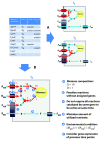Antimalarial drug targets in Plasmodium falciparum predicted by stage-specific metabolic network analysis
- PMID: 20807400
- PMCID: PMC2941759
- DOI: 10.1186/1752-0509-4-120
Antimalarial drug targets in Plasmodium falciparum predicted by stage-specific metabolic network analysis
Abstract
Background: Despite enormous efforts to combat malaria the disease still afflicts up to half a billion people each year of which more than one million die. Currently no approved vaccine is available and resistances to antimalarials are widely spread. Hence, new antimalarial drugs are urgently needed.
Results: Here, we present a computational analysis of the metabolism of Plasmodium falciparum, the deadliest malaria pathogen. We assembled a compartmentalized metabolic model and predicted life cycle stage specific metabolism with the help of a flux balance approach that integrates gene expression data. Predicted metabolite exchanges between parasite and host were found to be in good accordance with experimental findings when the parasite's metabolic network was embedded into that of its host (erythrocyte). Knock-out simulations identified 307 indispensable metabolic reactions within the parasite. 35 out of 57 experimentally demonstrated essential enzymes were recovered and another 16 enzymes, if additionally the assumption was made that nutrient uptake from the host cell is limited and all reactions catalyzed by the inhibited enzyme are blocked. This predicted set of putative drug targets, shown to be enriched with true targets by a factor of at least 2.75, was further analyzed with respect to homology to human enzymes, functional similarity to therapeutic targets in other organisms and their predicted potency for prophylaxis and disease treatment.
Conclusions: The results suggest that the set of essential enzymes predicted by our flux balance approach represents a promising starting point for further drug development.
Figures



Similar articles
-
In silico multiple-targets identification for heme detoxification in the human malaria parasite Plasmodium falciparum.Infect Genet Evol. 2016 Jan;37:237-44. doi: 10.1016/j.meegid.2015.11.025. Epub 2015 Dec 2. Infect Genet Evol. 2016. PMID: 26626103
-
Network-based assessment of the selectivity of metabolic drug targets in Plasmodium falciparum with respect to human liver metabolism.BMC Syst Biol. 2012 Aug 31;6:118. doi: 10.1186/1752-0509-6-118. BMC Syst Biol. 2012. PMID: 22937810 Free PMC article.
-
Novel Plasmodium falciparum metabolic network reconstruction identifies shifts associated with clinical antimalarial resistance.BMC Genomics. 2017 Jul 19;18(1):543. doi: 10.1186/s12864-017-3905-1. BMC Genomics. 2017. PMID: 28724354 Free PMC article.
-
A proteomic glimpse into the effect of antimalarial drugs on Plasmodium falciparum proteome towards highlighting possible therapeutic targets.Pathog Dis. 2021 Jan 9;79(1):ftaa071. doi: 10.1093/femspd/ftaa071. Pathog Dis. 2021. PMID: 33202000 Review.
-
Supply and demand-heme synthesis, salvage and utilization by Apicomplexa.FEBS J. 2021 Jan;288(2):382-404. doi: 10.1111/febs.15445. Epub 2020 Jun 23. FEBS J. 2021. PMID: 32530125 Review.
Cited by
-
What mRNA Abundances Can Tell us about Metabolism.Metabolites. 2012 Sep 12;2(3):614-31. doi: 10.3390/metabo2030614. Metabolites. 2012. PMID: 24957650 Free PMC article.
-
Biomedical applications of genome-scale metabolic network reconstructions of human pathogens.Curr Opin Biotechnol. 2018 Jun;51:70-79. doi: 10.1016/j.copbio.2017.11.014. Epub 2017 Dec 7. Curr Opin Biotechnol. 2018. PMID: 29223465 Free PMC article. Review.
-
Partial inhibition and bilevel optimization in flux balance analysis.BMC Bioinformatics. 2013 Nov 29;14:344. doi: 10.1186/1471-2105-14-344. BMC Bioinformatics. 2013. PMID: 24286232 Free PMC article.
-
Functional genomics of Plasmodium falciparum using metabolic modelling and analysis.Brief Funct Genomics. 2013 Jul;12(4):316-27. doi: 10.1093/bfgp/elt017. Epub 2013 Jun 22. Brief Funct Genomics. 2013. PMID: 23793264 Free PMC article.
-
Non-canonical metabolic pathways in the malaria parasite detected by isotope-tracing metabolomics.Mol Syst Biol. 2021 Apr;17(4):e10023. doi: 10.15252/msb.202010023. Mol Syst Biol. 2021. PMID: 33821563 Free PMC article.
References
-
- WHO. World Malaria Report 2008 http://apps.who.int/malaria/wmr2008/malaria 2008.pdf. Tech rep World Health Organization. 2008.
Publication types
MeSH terms
Substances
LinkOut - more resources
Full Text Sources

